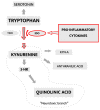Inflammatory Depression-Mechanisms and Non-Pharmacological Interventions
- PMID: 33561973
- PMCID: PMC7915869
- DOI: 10.3390/ijms22041640
Inflammatory Depression-Mechanisms and Non-Pharmacological Interventions
Abstract
Treatment of depression is hampered by the failure to identify distinct symptom profiles with distinct pathophysiologies that differentially respond to distinct treatments. We posit that inflammatory depression is a meaningful depression subtype associated with specific symptoms and biological abnormalities. We review several upstream, potentially causative, mechanisms driving low-grade inflammation in this subtype of depression. We also discuss downstream mechanisms mediating the link between inflammation and symptoms of depression, including alterations in dopaminergic neurotransmission and tryptophan metabolism. Finally, we review evidence for several non-pharmacological interventions for inflammatory depression, including probiotics, omega-3 fatty acids, and physical exercise interventions. While some evidence suggests that these interventions may be efficacious in inflammatory depression, future clinical trials should consider enriching patient populations for inflammatory markers, or stratify patients by inflammatory status, to confirm or refute this hypothesis.
Keywords: depression; dysbiosis; exercise; inflammation; n-3 PUFAs.
Conflict of interest statement
Daniel Lindqvist has received research support from Biogaia AB, and has received speaking honorarium from Janssen-Cilag AB and H. Lundbeck AB.
Figures





References
Publication types
MeSH terms
Substances
Grants and funding
LinkOut - more resources
Full Text Sources
Other Literature Sources
Medical

